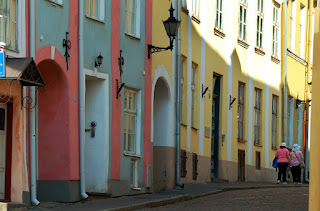
As I left the gold room, I could not resist the chance to use the giant mirror next to the exit door for a Gold-Room Self-Portrait.
As we moved on, we entered a series of dining rooms and drawing rooms, each one dominated by a Delft stove. The giant wood-burning stoves were specially made and ordered to be shipped in at great cost to add to the gilt in impressing people. I knew of Delft as pottery, interesting and beautiful but on a much smaller scale.
When the guide gave the background to the stoves, it sounded remarkable. The stoves were made without doors, no way to put the wood into the stove or burn it. The stoves are giant counterfeits. I need say no more, as I wrote about it in the semi-dark of that evening White Night. The poem I wrote:
DELFT
Catherine the Great, perhaps self-nicknamed so long ago, filled palaces
With collections of various artworks, sculpture, tapestries: everything
She apparently fancied. As gilted as Peterhof, her Winter Castle features
Delft stoves, hand fired in the Netherlands and shipped to her orders,
Floor-to-ceiling heating devices that are valuable collectors’ items.
Most though not all of these wood stoves were made without doors,
No way to add wood, no way to light a fire, no way to use the stove.
In a palace full of gilt, perhaps the greatest symbol of bloated excess
Might be the fanciest stoves of all, placed there just to impress.


























































